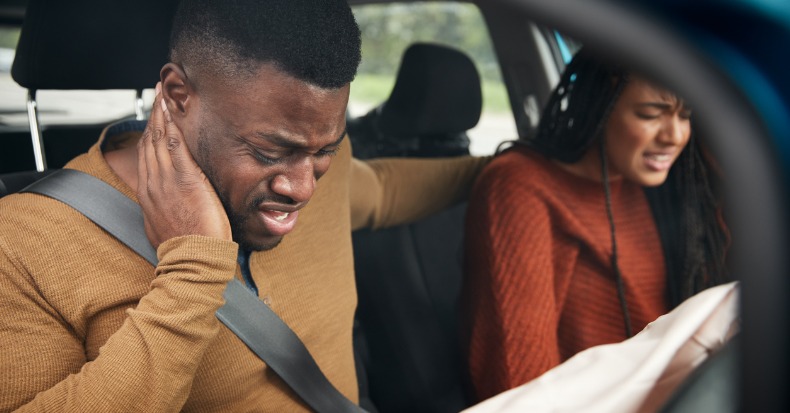Whiplash is a slang term for an injury to the neck that occurs as a result of a sudden jolt, classically occurring in a car accident (though a slip and fall injury can sometimes result in a similar condition). In a classic rear-end collision, the car is struck from behind and accelerated forward so fast that even if the person knew the impending collision was about to take place, bracing the body prior to impact would not prevent injury. In fact, muscles can only be voluntarily contracted at around 800-1000 msec. and in a rear end collision, the head is "whipped" within a 300-400 msec. time frame. Additionally, the muscles in the front of neck are stretched when the car is propelled forward, which leaves the head in a relatively extended backwards position. Most headrests in cars are not properly positioned so the head often goes back much further than the limits of our muscles, ligaments, and joints may allow resulting in the stretching and tearing of these tissues. When the tissues in the front of the neck are over stretched, the "rubber band" effect propels the head forward—overstretching the muscles, ligaments, and joints at the back of the spine. This "crack the whip" phenomenon occurs within 400-500 msec., far quicker than what we are capable of when voluntarily contracting our muscles. Here is a breakdown of what happens in a 5 mph (~8 km/h) rear-end collision:
0 msec.: At the moment of impact, the car seat just begins to move and the occupant has not yet been accelerated forward.
50 msec.: As the back of the car seat pushes the torso forward, the spine moves forward, resulting in a straightening of the thoracic and cervical spine. About 2-3 Gs of force are exerted on the torso.
75 msec.: This difference in motion between the neck and torso results in an S-shaped curve, where nearly all of the bending in the cervical spine takes place in the lower cervical spine. This rapid bending in just a few joints can result in ligament damage in the lower cervical spine.
150 msec.: Here, the torso has pulled so far forward on the lower neck that the head is forced backwards often over the head restraint. Depending on the position of the headrest, the angle of the seat back, and "spring" effect of the seatback, the ligaments in the front portion of the spine are often injured during this phase of the collision. About 3-4 Gs are exerted on the shoulders.
200 msec.: Finally, the force of the car seat throws the head and torso forward. Here, 5 Gs are exerted on the head and neck as it whips forwards. All of this is completed in less than 500 msec.
One of the reasons this occurs has to do with the ability of the car—particularly the back bumper to not deform so that the force of impact is transferred directly to the contents within the vehicle (ie., the passengers). At higher speeds, the crushing metal absorbs some of the impact and the contents are actually less jostled and thrown about. This helps explain how a "no damage" rear-end collision can result in greater injury than a higher speed collision.



